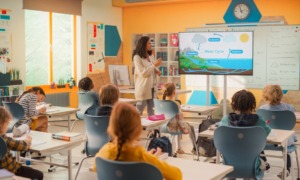![]() JOHN HOPKINS UNIVERSITY eSCHOOL+ INITIATIVE
JOHN HOPKINS UNIVERSITY eSCHOOL+ INITIATIVE
As school districts decide how to provide schooling this fall, they should take a close look at equity, according to the Johns Hopkins University Center for Safe and Healthy Schools. As part of that, state plans should take after-school programs into consideration, according to the newly released School Re-opening Policy Tracker.
The tracker looks at the reopening guidance issued by each state, the District of Columbia and two territories. It notes which considerations appear (including transportation, parent and teacher choice, before- and after-care, and the needs of low-income students, as well as core academics and virus protection strategies.
Especially for essential workers, “before and after-school care is an essential part of that conversation,” said Annette Anderson, deputy director for the Center for Safe and Healthy Schools.
“For a lot of families, having access to child care and extracurricular activities and athletics is important,” she said. “They need to be sure after-school plans are in place.”
She said 44 of the state plans include some consideration of after-school programs.
But only one-third of the 53 plans considered equity, she said. For example, did plans make sure students had access to digital technology? Did they include accommodations for the child care needs of families and offer after-school instructional programming? The tracker looked at whether the plan included those and other provisions to lessen the impact of school closures on children of poverty or systemic disadvantage.
These students are a subgroup most likely to experience learning loss, and also to need the health and mental health supports at schools, Anderson said.
“They tend to have more need,” and school is the place where they access many resources, she said.
School plans for the fall have become a flashpoint as President Donald Trump and some governors insist on having students return to school buildings even in areas where coronavirus cases are increasing.
The foremost consideration for returning to face-to-face schooling is whether community transmission of the coronavirus is under control, said Jennifer Nuzzo, an epidemiologist with the Johns Hopkins Center for Health Security, at a press briefing Thursday. To achieve that, leaders must insist on physical distancing in the community, strengthen the capacity of hospitals and establish contact tracing, she said.
Where schools can reopen, creative solutions are needed, Nuzzo said, such as using carpools in place of buses, having classes outdoors, staggering start times and keeping students in small groups that do not interact with other groups.
Parents should also have the choice to keep children home and school remotely, she said.
About 10% of all students live with grandparents, who because of their age are at higher risk from COVID-19, Anderson said.
In addition, teachers must have the choice to opt out of face-to-face teaching, according to The Ethics of K-12 School Reopening: Identifying and Addressing the Values at Stake released in June at John Hopkins. One in five teachers is 55 or older, it said.































